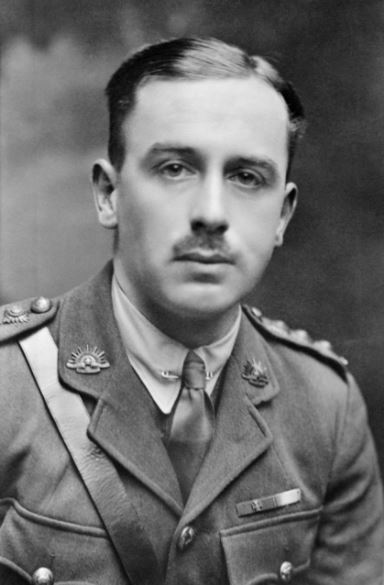Pilot Officer Rawdon Hume Middleton VC (1916 - 1942, 26yo)
 Ron Middleton was born on 22 July 1916 in Waverley, New South Wales. After completing his education, he enlisted in the Royal Australian Air Force on 14 October 1940 under the Empire Air Training Scheme. He trained as a pilot and was posted to Britain in September 1941.
Ron Middleton was born on 22 July 1916 in Waverley, New South Wales. After completing his education, he enlisted in the Royal Australian Air Force on 14 October 1940 under the Empire Air Training Scheme. He trained as a pilot and was posted to Britain in September 1941.
By December 1941, Middleton had been promoted to Flight Sergeant and was posted to No. 149 Squadron, Royal Air Force. In July 1942, he qualified as a First Pilot and Captain, assuming command of a Stirling bomber crew.
On the night of 28 November 1942, Middleton led a mission to bomb industrial targets in Turin, Italy. While over the target, his aircraft was struck by anti-aircraft fire, with a shell exploding in the cockpit. He sustained grievous injuries, including a shattered right eye socket and additional wounds to his body and legs. Despite the damage to the aircraft and his deteriorating condition, Middleton refused to divert to North Africa or order his crew to bail out over occupied France. His determination was driven by a desire to return his crew to the safety of England.
Enduring more than four hours of excruciating pain and impaired vision, Middleton eventually reached the English coast. He flew inland to allow his crew to parachute to safety. Five crew members survived the descent. With two remaining on board, he turned the stricken aircraft out to sea to avoid civilian casualties. The aircraft crashed into the English Channel in the early hours of 29 November 1942. Middleton was too weak to escape and was killed, along with the two crew members who had stayed with him.
His body washed ashore at Shakespeare Beach, Dover, in February 1943 and he was buried with full military honours at St John’s Churchyard, Beck Row, Suffolk. Middleton was posthumously awarded the Victoria Cross and promoted to Pilot Officer, effective from 15 November 1942. He became the first member of the RAAF to receive the Victoria Cross during the Second World War.
Middleton’s selfless devotion to duty and extraordinary bravery have endured as a symbol of courage in the face of overwhelming adversity.
Lieutenant Rupert Theo Vance (Mick) Moon VC (1892 - 1986, 93 yo)
 Rupert Vance "Mick" Moon was born on 14 August 1892 in Bacchus Marsh, Victoria. After completing his schooling at sixteen, he began work as a bank clerk. On 21 August 1914, he enlisted in the Australian Imperial Force as a trumpeter, joining the 4th Light Horse Regiment.
Rupert Vance "Mick" Moon was born on 14 August 1892 in Bacchus Marsh, Victoria. After completing his schooling at sixteen, he began work as a bank clerk. On 21 August 1914, he enlisted in the Australian Imperial Force as a trumpeter, joining the 4th Light Horse Regiment.
Deployed to Gallipoli in May 1915, Moon served as infantry during the campaign and remained until the evacuation in December. He was promoted to Sergeant in March 1916 and later transferred to the Western Front. In September of that year, he was commissioned as a Second Lieutenant and took command of a platoon in the 58th Battalion. He was promoted to Lieutenant in April 1917.
Moon's most celebrated action came during the second battle of Bullecourt on 12 May 1917, where the 58th Battalion breached the Hindenburg Line with support from the British 7th Division. Leading the assault on enemy defences, Moon personally attacked a concrete machine-gun post and a heavily fortified trench system. Despite being wounded four times, he continued to lead his platoon, successfully securing their objectives and capturing 186 German soldiers. His bravery was recognised with the award of the Victoria Cross. His citation noted that his "bravery was magnificent and was largely instrumental in the successful issue against superior numbers."
Sent home in early 1918 to recover, Moon later volunteered to return to active duty. He rejoined the 58th Battalion in August and participated in the operations at Mont St Quentin. In February 1919, he was promoted to temporary Captain and returned to Australia later that year as an honorary Captain. His service in the AIF officially ended in October 1919, and he was placed on the Reserve of Officers.
Moon struggled to adjust to civilian life, eventually leaving his job in banking. He later found success as a livestock manager. A passionate racehorse owner, he became a life and committee member of the Moonee Valley Racing Club and held memberships in several prominent racing and social clubs in Victoria. He passed away on 28 February 1986 at his home in Barwon Heads and was buried with Anglican rites at Mount Duneed Cemetery. He was survived by his wife, son, and daughter.
Last Reviewed 06/2025









